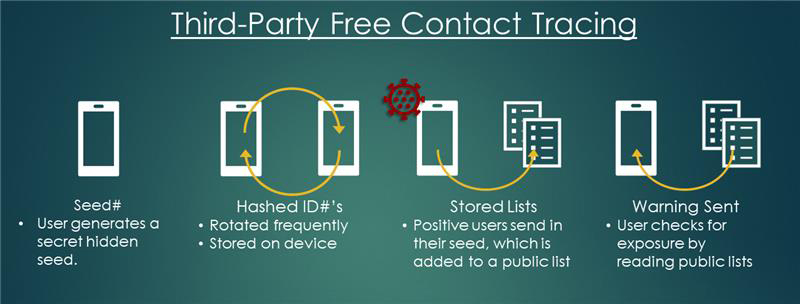If you build it, they will come.
That statement might hold true for a baseball field in rural Iowa — in the days before social distancing, that is — but what about when it comes to building mobile technologies to fight a global pandemic?
In the balance between individual civil liberties and the common good, there is an obvious tension between the urge to deploy the latest, greatest tools for tracking the spread of COVID-19 and the preservation of personal privacy. But according to a team of researchers and technologists affiliated with the Paul G. Allen School of Computer Science & Engineering, UW Medicine and Microsoft, there is a way to build technology that respects the individual and their civil liberties while supporting public health objectives and saving people’s lives.
In a white paper released yesterday, the team proposes a comprehensive set of principles to guide the development of mobile tools for contact tracing and population-level disease tracking while mitigating security and privacy risks. The researchers refer to these principles as PACT, short for “Privacy Sensitive Protocols and Mechanisms for Mobile Contact Tracing.”
“Contact tracing is one of the most effective tools that public health officials have to halt a pandemic and prevent future breakouts,” explained professor Sham Kakade, who holds a joint appointment in the Allen School and the UW Department of Statistics. “The protocols in PACT are specified in a transparent manner so the tradeoffs can be scrutinized by academia, industry, and civil liberties organizations. PACT permits a more frank evaluation of the underlying privacy, security, and re-identification issues, rather than sweeping these issues under the rug.”
If people were not familiar with the concept of contact tracing before, they surely are now with the outbreak of COVID-19. Public health officials have been relying heavily on the process to identify individuals who may have been exposed through proximity to an infected person to try and halt further spread of the disease. Several governments and organizations have deployed technology to assist with their response; depending on the situation, participation may be voluntary or involuntary. Whether optional or not, the increased use of technology to monitor citizens’ movements and identify other people with whom they meet has rightly sparked concerns around mass surveillance and a loss of personal privacy.
The cornerstone of the PACT framework put forward by the UW researchers is a third-party free approach, which Kakade and his colleagues argue is preferable to a “trusted third party” (TTP) model such as that used for apps administered by government agencies. Under PACT, strict user privacy and anonymity standards stem from a decentralized approach to data storage and collection. The typical TTP model, on the other hand, involves a centralized registration process wherein users subscribe to a service. While this can be a straightforward approach and is one that will be very familiar to users, it also centrally aggregates personally sensitive information that could potentially be accessed by malicious actors. This aggregation also grants the party in question — in this case, a government agency — the ability to identify individual users and to engage in mass surveillance.
The team’s white paper lays out in detail how mobile technologies combined with a third-party free approach can be used to improve the speed, accuracy, and outcomes of contact tracing while mitigating privacy concerns and preserving civil liberties. These include the outline of an app for conducting “privacy-sensitive” mobile contact tracing that relies on Bluetooth-based proximity detection to identify instances of co-location — that is, instances of two phones in proximity, via their pseudonyms — to determine who may be at risk. The team prefers co-location to absolute location information because it is more accurate than current GPS localization technologies, such as those in popular mapping and navigation apps, while affording more robust privacy protections to the user. Depending on the nature of the specific app, such a system could be useful in allowing people who test positive for the disease to securely broadcast information under a pseudonym to other app users who were in close proximity to them, without having to reveal their identity or that of the recipients.
Another example of how PACT can aid in the pandemic response include mobile-assisted contact tracing interviews. In this scenario, a person who tests positive completes a form on their smartphone listing their contacts in advance of the interview; the data remains on the person’s device until they choose to share it with public health officials. The team also describes a system for enabling narrowcast messages, which are public service messages pushed out from a government agency to a subset of the citizenry. Such communications might be used to inform people living in a specific area of local facility closures due to an outbreak, or to notify them in the event that they were at a location during the same time frame as a person who subsequently tested positive for the disease.
In all cases, the researchers advocate for retaining data locally on the person’s device until they initiate a transfer.
“Only with appropriate disclosures and voluntary action on the part of the user should their data be uploaded to external servers or shared with others — and even then, only in an anonymized fashion,” explained Allen School professor Shyam Gollakota. “We consider it a best practice to have complete transparency around how and where such data is used, as well as full disclosure of the risks of re-identification from previously anonymized information once it is shared.”
Gollakota and his colleagues emphasize that technology-enabled contact tracing can only augment — not entirely replace — conventional contact tracing. In fact, two out of the three applications they describe are designed to support the latter and were developed with input from public health organizations and from co-author Dr. Jacob Sunshine of UW Medicine. There is also the simple fact that, despite their seeming ubiquity, not everyone has a smartphone; of those who do, not everyone would opt to install and use a contact-tracing app.
As Allen School professor and cryptography expert Stefano Tessaro notes, all contact tracing — whether conventional or augmented with technology — involves tradeoffs between privacy and the public good.
“Contact tracing already requires a person to give up some measure of personal privacy, as well as the privacy of those they came into contact with,” Tessaro pointed out. “However, we can make acceptable tradeoffs to enable us to use the best tools available to speed up and improve that process, while ensuring at the same time meaningful privacy guarantees, as long as the people creating and implementing those tools adhere to the PACT.”
The team, which also includes Allen School Ph.D. students Justin Chan and Sudheesh Singanamalla, postdoctoral researcher Joseph Jaeger, and professor Tadayoshi Kohno — along with the technologists John Langford, Eric Horvitz, and Jonathan Larson at Microsoft — posted its white paper on the preprint site arXiv.org to encourage broad dissemination and conversation around this topic. Read the full paper here.



